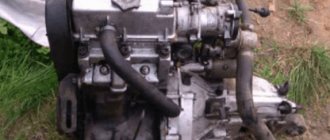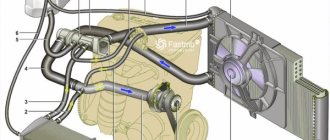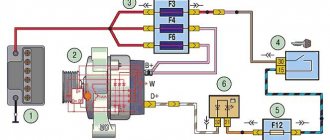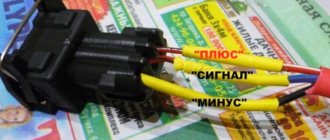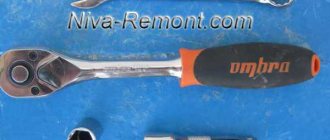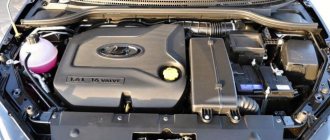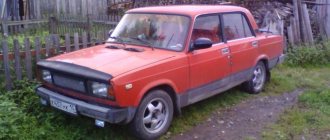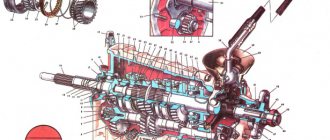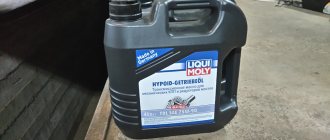Repair and maintenance of the lubrication system
The main malfunctions of the lubrication system are: 1) oil leakage at the joints; 2) increased or decreased oil pressure in the lubrication system or its complete absence; 3) increased oil consumption; 4) malfunction of the engine crankcase ventilation.
Oil leakage can be detected during an external inspection of the engine, as well as by oil stains where the car is parked. This malfunction can be eliminated by tightening the fastening elements of the connections. Increased oil pressure may be a result of using the wrong oil, which has a high viscosity. In addition, increased pressure may occur due to contamination of the oil line and sticking of the pressure relief valve in the closed position. Normal oil pressure in a warm engine should be approximately 0.35-0.45 MPa. The pressure is controlled using a pointer and a red warning lamp located on the instrument panel.
Low oil pressure may be due to oil dilution. In addition, low pressure can be caused by wear of the main and connecting rod bearings of the crankshaft and pump gears, as well as loose closure of the pressure relief valve or its jamming in the open position. When low oil pressure occurs, it is necessary to immediately determine its cause and eliminate it. Lack of oil pressure may be caused by a malfunction of the oil pump or its drive. In some cases, the reason why the oil pump stops working is a violation of the splined connection of the pump drive shaft and the drive gear due to their wear.
If the oil pressure suddenly drops to the point of no oil pressure, you must immediately turn off the engine and check the oil level. If the oil level is normal, then you need to remove the oil pressure sensor and turn the engine crankshaft with a starter. If, during rotation, an oil stream is knocked out, this means that the oil pressure sensor is faulty and needs to be replaced. If there is no stream of oil, this indicates a malfunction of the oil pump or its drive.
In the absence of oil pressure or when the oil pressure indicator light is on, it is permissible to continue driving the vehicle only if it is precisely established that such readings from the control instruments are caused by their malfunction. If the cause of the low oil pressure cannot be identified, then it is necessary to stop driving the vehicle and tow it to a service station to have the problem repaired. It must be taken into account that even short-term movement of the vehicle in the absence of oil pressure can lead to serious engine damage.
Increased oil consumption may be a result of oil leakage at the connections. In addition, increased oil consumption can be caused by its entry into the combustion chambers due to wear of the valve oil seals, wear of parts of the cylinder-piston group, as well as the result of an increased oil level as a result of its overflow. In addition, increased oil consumption is observed during the running-in period of a new car in the first 5,000 km.
Malfunction of the engine crankcase ventilation system occurs as a result of dirt getting into it. The most dangerous is contamination of the oil deflector, crankcase slope tubes, and carburetor spool device. Malfunction of the ventilation system is manifested in increased oil consumption, increased oil pressure, as well as oil entering the air filter and carburetor. In order to eliminate a violation of the crankcase ventilation system, it is necessary to clean, rinse and blow with compressed air the oil separator, the carburetor spool device, and the crankcase gas suction tubes.
Purpose of the engine lubrication system
A misconception is to think that it is intended only for lubricating moving elements.
In fact, oil performs a number of auxiliary functions:
- Cooling a car engine using air and antifreeze alone is not effective enough. Motor oil is an excellent conductor of heat. Engineers took advantage of this to transfer temperature to the outer walls of the engine housing, which are cooled by the air flow from the fan. In some models, the lubricant even flows through a special radiator.
- The hydraulic capabilities of the oil are also in demand. If in an automatic transmission this is one of the main tasks, then in an internal combustion engine it is considered an auxiliary one. The hydraulic compensators of the valves of the gas distribution mechanism are filled with liquid lubricant from the crankcase. With its help, the required clearance in the timing system is maintained.
- If the car is equipped with a variable intake timing system, the oil participates in the operation of the phase shifters, reducing fuel consumption and increasing engine power.
- In addition, the internal combustion engine lubrication system is involved in the operation of the electronic engine control unit. Fluid temperature measurements affect the process of forming the fuel-air mixture (proportion of gasoline and air).
- Maintaining working clearances in rubbing and rotating parts, reducing wear. This means increasing the time until major repairs and preventing the risk of a malfunction.
- And finally, by reducing friction, mechanical losses are reduced (motor efficiency increases). The result is a reduction in fuel consumption.
What else is the lubrication system used for?
With its help, the internal cavities of the motor are cleaned. High-quality oil with detergent additives dissolves slag deposits on the walls and gears. Then the system drives the dirty suspension into the oil filter, and all the debris remains in it.
Learn more about the purpose of the engine lubrication system in this video
Main defects of cooling system devices
The first common cooling system problem is a coolant leak. Leaks may appear in the engine channels and radiator. At each maintenance, it is necessary to check the engine for leaks. If a leak is found, it must be repaired or it will cause the engine to overheat.
If a leak appears, the problem may be a faulty radiator cap. The cause is excess pressure and the cap does not bypass coolant.
Antifreeze is leaking
Oil pump
The engine lubrication system circuit includes an oil pump. It is used to pressurize the lubricant into the system. The drive of the device is mechanical, carried out from the crankshaft or camshaft of the power unit.
The pump inlet communicates with the crankcase cavity or a separate lubricant reservoir. The outlet is connected to the main line of the motor. The devices come in various designs. The most commonly used pumps are gear type. They are reliable and unpretentious to the conditions of use.
When the power plant operates, the gears of the unit rotate. The lubricant, falling on the gears, moves to the main line. Thanks to this design, pressure is created in the system.
Bypass mechanism
The design of the internal combustion engine provides for a bypass mechanism. It is designed as a one-way valve. When the pressure in the main line exceeds, the bypass mechanism opens and allows part of the lubricant to flow into the crankcase pan.
Oil receiver
Used to collect oil from the oil pan. The oil receiver is connected to the pump inlet. The connection between the pump inlet and the oil receiver is sealed. This prevents air from entering the system.
Filter
During operation of the power unit, the lubricant is cleared of metal shavings and contaminants. Cleaning is carried out using coarse and fine filters. Fine filters are used in passenger cars. Rough cleaning is performed by a mesh installed on the oil receiver.
Diesel power plants are equipped with centrifugal-type coarse filters. They consist of a glass inside with a movable sprinkler installed. During operation, oil under pressure is sprayed onto the walls of the glass. Contaminants remain on the glass. The purified oil drains into the crankcase cavity.
Before entering the main line, the lubricant passes through a fine filter.
It consists of paper filter elements. Paper elements trap fine contaminants. If the fine filter element is heavily soiled, it must be completely replaced.
What is an engine lubrication system for?
The internal combustion engine of any vehicle consists of many elements that interact very aggressively with each other during its operation. Due to their constant movement inside the installation, a high friction force arises, leading to large power losses and, as a consequence, increased fuel consumption.
Prolonged operation “dry” can even lead to jamming of the power unit: increased interaction of parts will lead to heating of their surfaces and further expansion; as a result, this will reduce the working gaps of the structure and will lead to their filling with metal shavings formed as a result of the destruction of the main elements.
To prevent this condition and extend its useful life, the internal combustion engine is equipped with a lubrication structure that facilitates the movement of parts, creating a strong protective film around the elements of the internal combustion system.
Thus, the lubrication system of any two-stroke or four-stroke engine performs the following number of functions:
- Reducing the friction force between working elements;
- Cooling their surfaces;
- Reduced engine operating temperature;
- Removal of metal shavings and contaminants outside the working space of the installation;
- Prevention of rapid wear, destruction and coking of parts;
- Ensuring the required working fluid pressure for efficient operation of the internal combustion engine (changing the timing of the gas distribution mechanism, adjusting the operating valve clearances with hydraulic compensators).
A little about combined lubrication
The principle of operation is the continuous circulation of lubricating fluid inside the power unit. Just as in the human body the heart supplies blood to all organs, so the oil pump feeds first the large arteries, and then the thinner channels. Automobile pumps create a pressure from 2 to 20 atm.
The most common are gear devices. They rarely install adjustable plate ones. A pressure reducing valve is used to maintain pressure. Inside it there is a spring-loaded plunger, which, after a certain compression of the spring, communicates the pressure line with the crankcase. The oil after the pump passes through a filter, in which another bypass valve can be installed.
Next, the oil is sent: to the crankshaft support and connecting rod journals, to the camshaft supports and cams, to water the timing parts (pushers, rocker arms, valves). The operation of the combined system is accompanied by washing off the remains of unburned fuel and wear particles from the cylinder mirrors, which flow into the crankcase and deteriorate the quality of the working oil.
Radiator
Main radiator defects:
- core contamination;
- scale deposits;
- leaking pipes.
Dirt and scale are removed by washing with a special solution. To determine the leakage points, it is necessary to close the lower pipe and the radiator neck with wooden plugs, and install a plug with a hose for the air pump in the upper pipe. The radiator is placed in a bath of water and air is pumped into it. Emerging bubbles indicate damaged areas. Soldering of the outer tubes is carried out without disassembling the radiator. As for the internal tubes that are not available for soldering, no more than 8-10% of their total number can be plugged. If more tubes are damaged, they are replaced with new ones.
To replace the tube you need:
- unsolder the radiator tanks from the core;
- insert a round or flat metal rod (in the shape of the tube) into the tube and heat the soldering area of the tube (on both ends) with a blowtorch or soldering iron;
- clamp the end of the tube with pliers and, pressing it against the rod, remove it from the core;
- to insert a new tube, it must be put on the rod and threaded into the holes of the cooling fins;
- distribute the ends of the tube with a beard and solder them with a soldering iron.
Check the repaired radiator again in a bath under air pressure.
